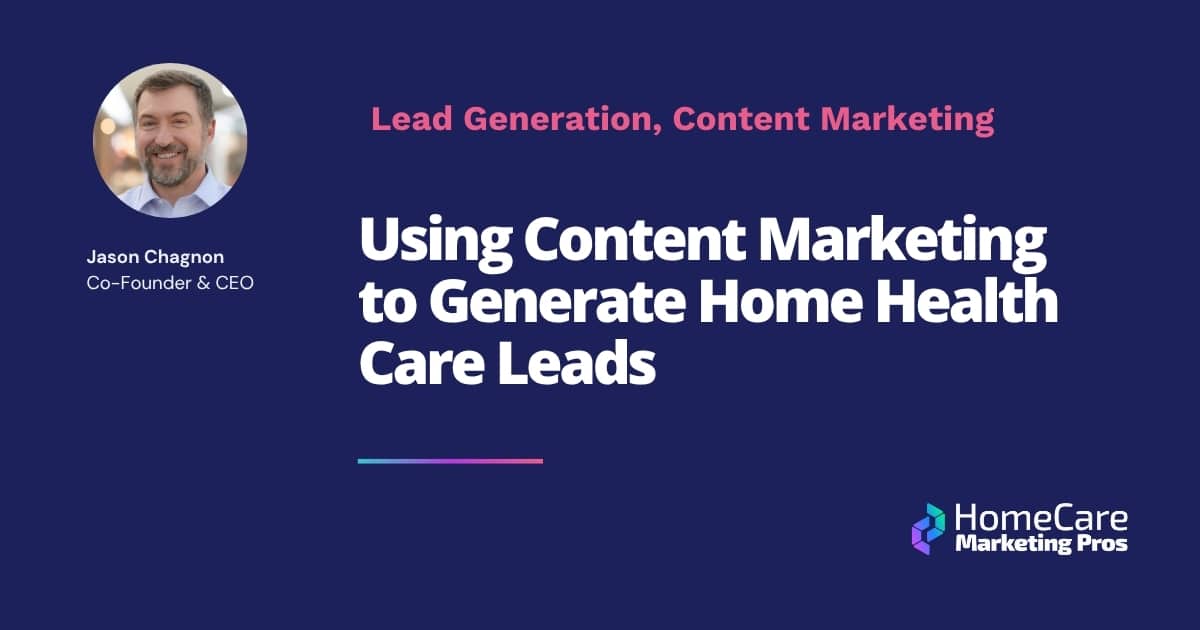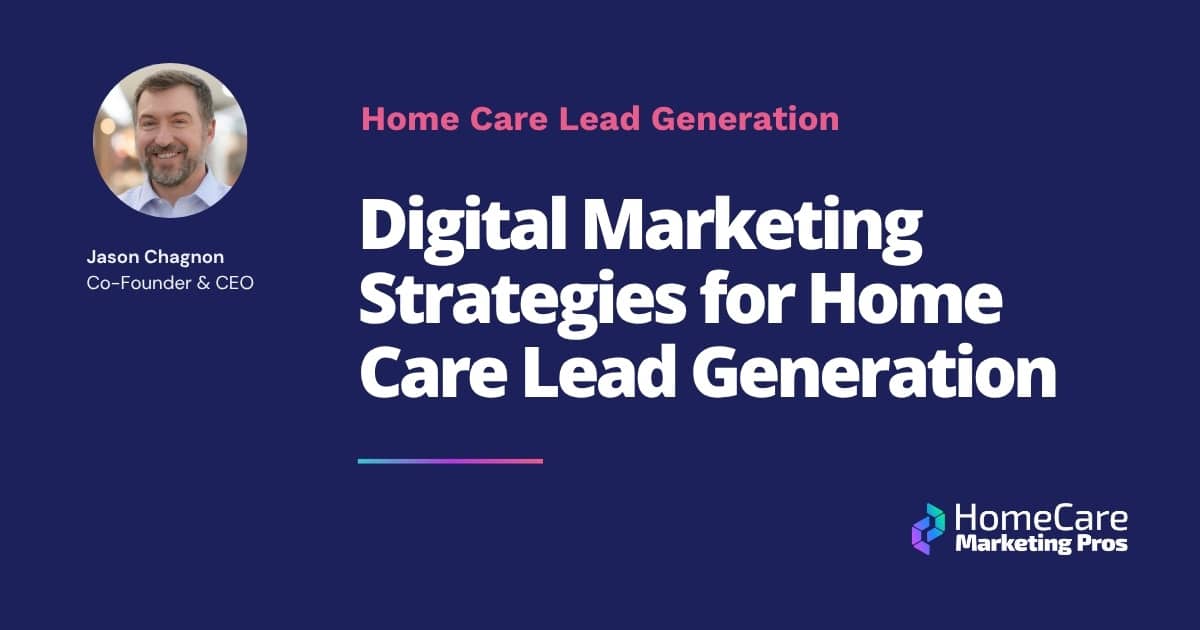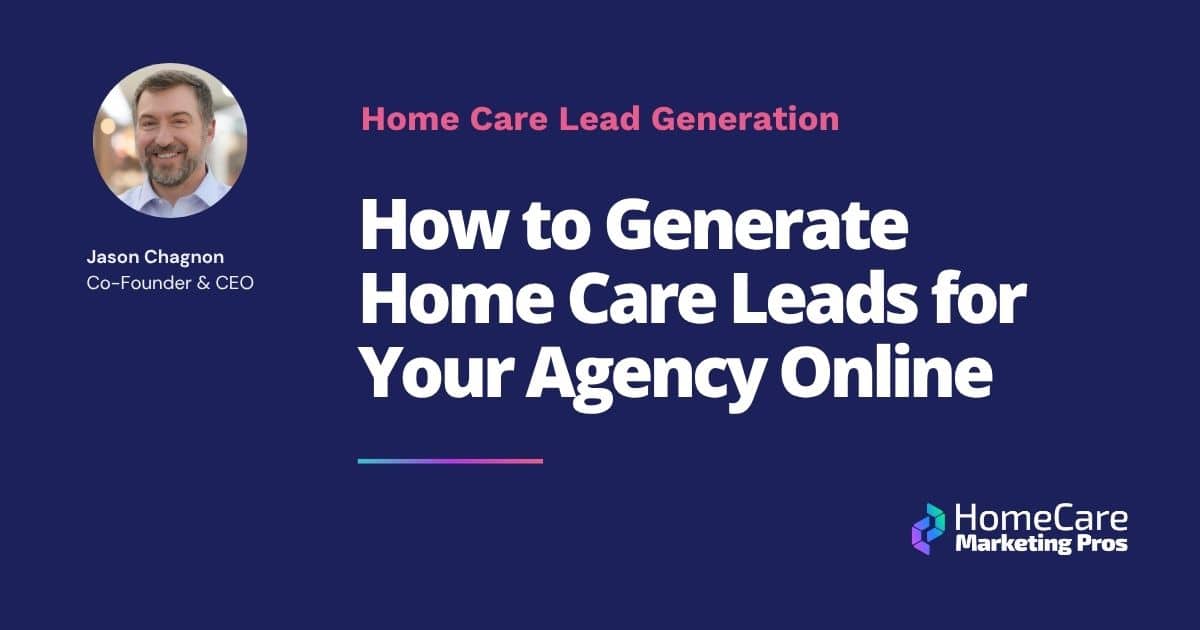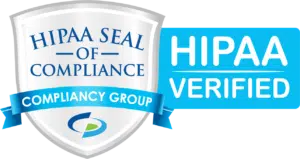
Jason Chagnon
Co-Founder & CEO
Reading time - 7 minutes

Should You Buy Home Care Leads? The Pros and Cons
Introduction
The demand for in-home care is growing rapidly as more families seek reliable support for their aging loved ones. For home care agencies, this creates a wealth of opportunity—but also significant competition. One of the most common questions owners and marketers ask is: should you buy home care leads?
Home care marketing is a comprehensive approach that agencies use to attract and retain clients, combining strategies like content creation, reputation management, and SEO websites.
At first glance, buying leads from large providers like A Place For Mom or Caring.com seems like a quick way to grow. These companies already attract families searching for senior care services, and by paying for access—and by having a professional website to draw in potential clients—agencies can fill their pipelines almost immediately. But is buying leads a sustainable strategy? In this article, we’ll explore the pros and cons of buying leads while also sharing home care lead generation tips to help agencies thrive long-term.
What Are Home Care Leads?
A home care lead is essentially a potential lead or potential client—someone actively looking for senior care services. Agencies are always seeking new leads to grow their business. These leads can be acquired in two main ways. Some buy them from third-party providers, while others generate them organically through their own marketing channels.
Purchased leads typically come from companies that invest heavily in advertising and search engine marketing, then sell those inquiries to agencies. For example, A Place For Mom and Caring.com dominate this space, funneling large numbers of prospects into the industry. Organic leads, on the other hand, come from strategies like search engine optimization, referral programs, or local community outreach. Optimizing your Google Business Profile, including accurate location and phone numbers, is crucial for local visibility and attracting potential clients. All of these methods can drive growth, but they work in very different ways. It’s important to focus on generating qualified leads rather than less relevant inquiries.
The Advantages of Buying Home Care Leads
One of the biggest advantages of buying senior care leads is speed. Instead of waiting months for your marketing campaign to build momentum, you get instant access to families actively searching for care. This gives agencies the advantage of bypassing lengthy marketing efforts and immediately offering their service to those in need. Tracking conversion rates from purchased leads is also important to measure how effectively these leads turn into clients. This makes lead purchasing particularly appealing for newer agencies or those looking to fill caregiver schedules quickly.
There’s also a sense of cost control. While digital ads can be unpredictable, purchasing leads gives you a clear price per contact. Established providers like A Place For Mom and Caring.com are companies that come with the added benefit of brand recognition. Since these companies already attract a steady stream of families searching for help, agencies can piggyback on that demand. For agencies that need flexibility, buying leads can be a way to scale up or down depending on immediate business needs. If managed well, a steady stream of quality leads can result in more home care clients and a strong reputation for your service.
The Disadvantages of Buying Home Care Leads
Despite its benefits, purchasing leads comes with challenges. Quality is a frequent concern. Not every lead is truly ready to commit, and agencies often find themselves chasing unqualified or duplicate inquiries. Many purchased leads are actually existing leads that are shared with multiple agencies at once, so you might find yourself competing with two or three other providers for the same family’s attention.
Relying on purchased leads can also make it harder to build trust with a potential customer, since they may be contacted by several agencies and feel overwhelmed or skeptical. This can impact your ability to turn prospects into loyal customers.
There’s also the uncertainty of return on investment. While some leads convert into long-term clients, others may never move forward, making it hard to predict the real profitability. Perhaps the biggest long-term risk is dependence. Relying too heavily on third-party lead generators can put your business at the mercy of their pricing, policies, or even fluctuations in lead quality. Evaluating the effectiveness of your lead sources through online reviews and customer feedback is essential to ensure you are investing in strategies that truly help you build trust and grow your business.
Cost Analysis: Buying vs. Building Leads
The cost of purchased home care leads typically ranges between $30 and $100, depending on the provider and market. On the surface, this might seem reasonable compared to running large advertising campaigns. However, once you factor in the effort of competing with other agencies and the likelihood of low-converting leads, the numbers can add up quickly.
In contrast, investing in your own home care business lead generation techniques—such as SEO, content marketing, and referral networks—can deliver more predictable results over time. Building your own system involves using marketing tools, creating and optimizing key assets like your home care website, and developing content that promotes your services. By creating and managing these assets, your company gains full ownership of the lead generation process. Although creating organic traffic and building brand reputation requires patience, it often yields higher-quality leads that are exclusive to your agency. The long-term return on investment tends to be stronger because your company owns the system rather than renting it.
Best Practices if You Decide to Buy Home Care Leads
If you choose to purchase leads, it’s important to approach the process strategically. Start by researching providers carefully and selecting a partner or partners with transparent methods and strong reputations. Consider partnering with organizations or reaching out to complementary businesses to expand your lead sources.
Once you begin receiving leads, ensure your dedicated team is ready to manage prompt follow-up. Families often reach out to multiple agencies, so contacting them within minutes can significantly improve your conversion rate. Use email marketing as an effective follow-up strategy to nurture purchased leads and increase engagement.
Tracking results is equally critical. Monitor which leads actually convert into clients by treating each lead source as a campaign, allowing you to optimize and calculate the true ROI of your investment. Announce new services or successes with press releases to further boost your visibility and credibility.
Finally, balance is key. Even if purchased leads deliver short-term results, they should never be your sole source of growth. Blending them with organic marketing strategies creates a healthier and more sustainable pipeline.
Alternatives: Home Care Lead Generation Tips
While purchased leads can play a role in growth, the most successful agencies invest in lead generation for their own home care agency that they control. For example, search engine optimization and content marketing allow you to attract families searching for answers online and appear prominently in the search results, including the map pack, to boost online visibility and attract more leads. Managing and actively posting on your agency’s social media and local social media pages will increase engagement with potential clients. Sharing updates about your home care services or home health services, and consolidating feedback from satisfied clients, will build trust and a positive reputation.
Participating in community events, such as sponsoring caregiver support groups or hosting educational events, helps establish credibility, generate leads, and build relationships within the community. Word-of-mouth referrals from family and friends are invaluable, and formalizing this process through referral marketing campaigns can help your home care agency attract more leads. Encourage satisfied clients to refer your service to their network, leveraging the power of happy clients to grow your business.
Paid advertising options like local services ads, pay per click, and Google Ads campaigns can further increase your online visibility and help generate leads by targeting those searching for home care services or home health support. Instead of relying on third-party providers, agencies can direct prospects to their own landing pages, ensuring those leads belong exclusively to them. These home care lead generation tips ensure that your marketing dollars build long-term value by promoting your home care services and service offerings, rather than disappearing into someone else’s system.
Conclusion
So, should you buy home care leads? The answer depends on your immediate needs and long-term goals. Buying leads can be a quick and sometimes cost-effective way to acquire clients, especially when schedules need filling fast. But the risks—such as unqualified prospects, heavy competition, and reliance on third-party providers—cannot be ignored.
The smartest approach is to view purchased leads as a supplement rather than a foundation. Combine them with proven lead generation techniques for home care businesses such as SEO, referrals, and community engagement. That way, you’ll benefit from both short-term growth and long-term stability. In the end, the agencies that thrive are those that don’t just buy leads—they build them.
Need help building your leads organically? We can help. Click here to get started!













